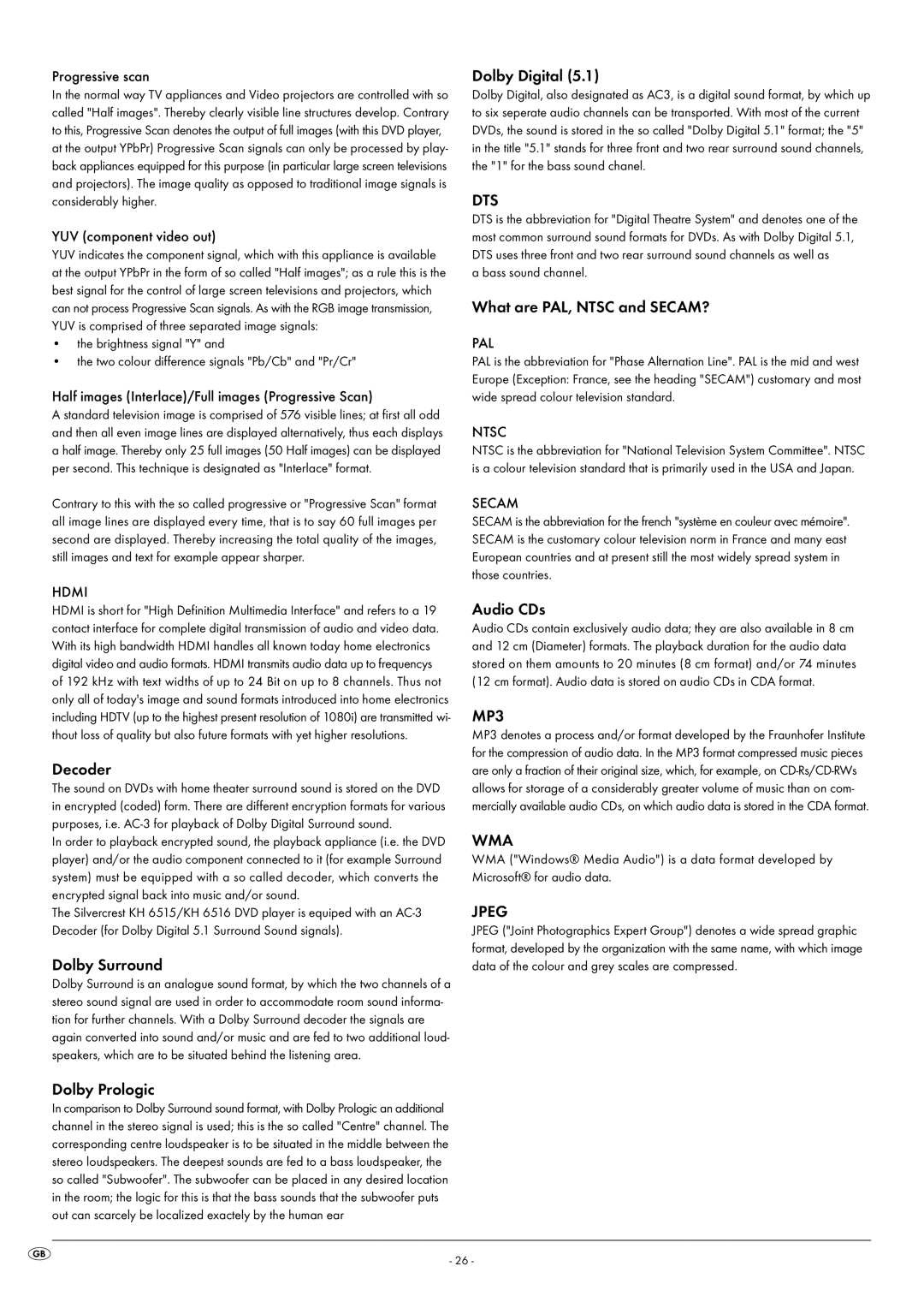
Progressive scan
In the normal way TV appliances and Video projectors are controlled with so called "Half images". Thereby clearly visible line structures develop. Contrary to this, Progressive Scan denotes the output of full images (with this DVD player, at the output YPbPr) Progressive Scan signals can only be processed by play- back appliances equipped for this purpose (in particular large screen televisions and projectors). The image quality as opposed to traditional image signals is considerably higher.
YUV (component video out)
YUV indicates the component signal, which with this appliance is available at the output YPbPr in the form of so called "Half images"; as a rule this is the best signal for the control of large screen televisions and projectors, which can not process Progressive Scan signals. As with the RGB image transmission, YUV is comprised of three separated image signals:
•the brightness signal "Y" and
•the two colour difference signals "Pb/Cb" and "Pr/Cr"
Half images (Interlace)/Full images (Progressive Scan)
A standard television image is comprised of 576 visible lines; at first all odd and then all even image lines are displayed alternatively, thus each displays a half image. Thereby only 25 full images (50 Half images) can be displayed per second. This technique is designated as "Interlace" format.
Contrary to this with the so called progressive or "Progressive Scan" format all image lines are displayed every time, that is to say 60 full images per second are displayed. Thereby increasing the total quality of the images, still images and text for example appear sharper.
HDMI
HDMI is short for "High Definition Multimedia Interface" and refers to a 19 contact interface for complete digital transmission of audio and video data. With its high bandwidth HDMI handles all known today home electronics digital video and audio formats. HDMI transmits audio data up to frequencys of 192 kHz with text widths of up to 24 Bit on up to 8 channels. Thus not only all of today's image and sound formats introduced into home electronics including HDTV (up to the highest present resolution of 1080i) are transmitted wi- thout loss of quality but also future formats with yet higher resolutions.
Decoder
The sound on DVDs with home theater surround sound is stored on the DVD in encrypted (coded) form. There are different encryption formats for various purposes, i.e.
In order to playback encrypted sound, the playback appliance (i.e. the DVD player) and/or the audio component connected to it (for example Surround system) must be equipped with a so called decoder, which converts the encrypted signal back into music and/or sound.
The Silvercrest KH 6515/KH 6516 DVD player is equiped with an
Dolby Surround
Dolby Surround is an analogue sound format, by which the two channels of a stereo sound signal are used in order to accommodate room sound informa- tion for further channels. With a Dolby Surround decoder the signals are again converted into sound and/or music and are fed to two additional loud- speakers, which are to be situated behind the listening area.
Dolby Prologic
In comparison to Dolby Surround sound format, with Dolby Prologic an additional channel in the stereo signal is used; this is the so called "Centre" channel. The corresponding centre loudspeaker is to be situated in the middle between the stereo loudspeakers. The deepest sounds are fed to a bass loudspeaker, the so called "Subwoofer". The subwoofer can be placed in any desired location in the room; the logic for this is that the bass sounds that the subwoofer puts out can scarcely be localized exactely by the human ear
Dolby Digital (5.1)
Dolby Digital, also designated as AC3, is a digital sound format, by which up to six seperate audio channels can be transported. With most of the current DVDs, the sound is stored in the so called "Dolby Digital 5.1" format; the "5" in the title "5.1" stands for three front and two rear surround sound channels, the "1" for the bass sound chanel.
DTS
DTS is the abbreviation for "Digital Theatre System" and denotes one of the most common surround sound formats for DVDs. As with Dolby Digital 5.1, DTS uses three front and two rear surround sound channels as well as
a bass sound channel.
What are PAL, NTSC and SECAM?
PAL
PAL is the abbreviation for "Phase Alternation Line". PAL is the mid and west Europe (Exception: France, see the heading "SECAM") customary and most wide spread colour television standard.
NTSC
NTSC is the abbreviation for "National Television System Committee". NTSC is a colour television standard that is primarily used in the USA and Japan.
SECAM
SECAM is the abbreviation for the french "système en couleur avec mémoire". SECAM is the customary colour television norm in France and many east European countries and at present still the most widely spread system in those countries.
Audio CDs
Audio CDs contain exclusively audio data; they are also available in 8 cm and 12 cm (Diameter) formats. The playback duration for the audio data stored on them amounts to 20 minutes (8 cm format) and/or 74 minutes (12 cm format). Audio data is stored on audio CDs in CDA format.
MP3
MP3 denotes a process and/or format developed by the Fraunhofer Institute for the compression of audio data. In the MP3 format compressed music pieces are only a fraction of their original size, which, for example, on
WMA
WMA ("Windows® Media Audio") is a data format developed by Microsoft® for audio data.
JPEG
JPEG ("Joint Photographics Expert Group") denotes a wide spread graphic format, developed by the organization with the same name, with which image data of the colour and grey scales are compressed.
- 26 -
